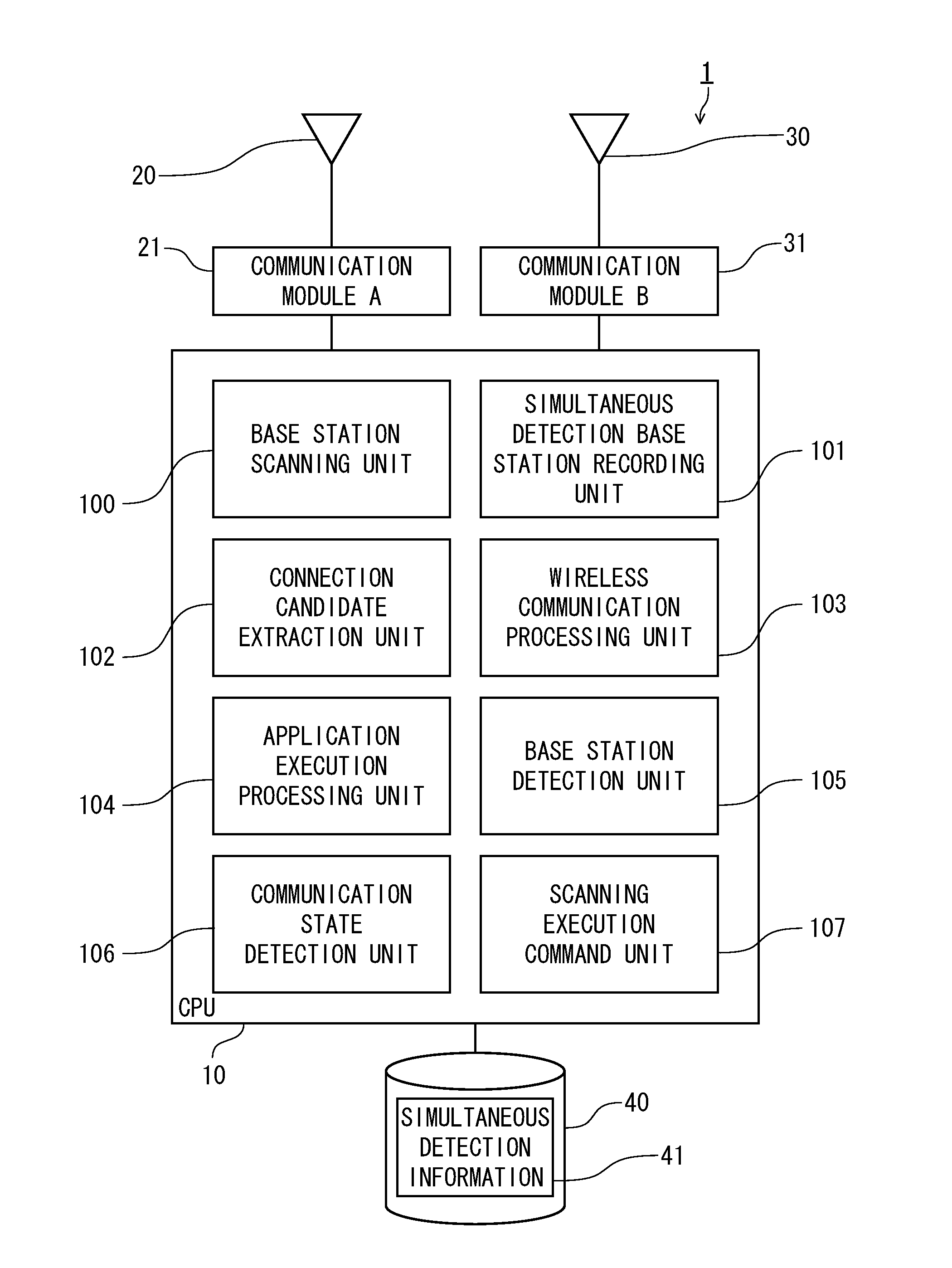Wireless communication terminal and wireless communication system
a wireless communication system and wireless communication technology, applied in the field of wireless communication terminals, can solve the problems of affecting communication quality, requiring a relative long time, and reducing the accuracy of information for connection candidate base stations in the wireless communication system, so as to improve the accuracy of information for connection candidate base stations, reduce the size, power consumption and the cost of equipmen
- Summary
- Abstract
- Description
- Claims
- Application Information
AI Technical Summary
Benefits of technology
Problems solved by technology
Method used
Image
Examples
example 1
Configuration of Single Wireless Communication Terminal
[0088]FIG. 1 shows a wireless communication terminal (1) according to the present invention. In addition to a known personal computer, the wireless communication terminal (1) may be realized by any of a mobile telephone terminal, or a mobile communication terminal such as a PDA.
[0089]As is well known, in addition to cooperation between a CPU (10) performing computational processing and the like and a memory (not shown), the configuration of this type of terminal is provided with a display device such as a monitor and an input device (not shown) such as a keyboard, mouse or touchpad. Furthermore an external storage device (40) configured by a hard drive or a flash memory, a communication module A(21) and an antenna (20) are provided for communication with a wireless communication network. A plurality of communication modules may be provided for communication with a plurality of wireless communication networks and, as shown in FIG...
example 2
Recording Three or More Simultaneous Detection Base Stations
[0148]In the configuration in Example 1, when two base stations AP1, AP2 are simultaneously detected in the simultaneous detection base station recording unit (101), a value of 1 was added to the term for AP2 in the simultaneous detection information for AP1 and a value of 1 was added to the term for AP1 in the simultaneous detection information for AP2.
[0149]Even when three base stations AP1, AP2, AP4 are simultaneously detected, combinations of two base stations are created and a matrix (Expression 2) in which CDTA12, CDTA14, CDTA21, CDTA24, CDTA41, CDTA42 have respective values of 1 is created as described above.
[0150]According to this method, when the base station performing current communication is AP1, a simultaneous detection probability is calculated for any single base station when selecting the connection candidate base station for subsequent connection.
[0151]However as shown in FIG. 8, when a plurality of base st...
example 3
[0189]In Example 1 and 2, simultaneous detection information was described with reference to a process in which each element in CDTA was increased by a value of 1 based on the detection frequency for each base station. This example describes a process of varying an increasing value in response to a communication parameter related to a given base station and not only the use of a frequency.
[0190]In this example, a radio-wave intensity of a detected base station (radio field intensity) is used as a communication parameter to vary a value which is incremented in response to the intensity.
[0191]A radio-wave intensity is expressed in a range of 0-1 when a predetermined value which is sufficient for communication is given a value of 1 (100%). For example, when AP1 and AP2 are detected simultaneously, if the radio-wave intensity of AP2 is 0.8, a value of 0.8 is added to CDTA12. The frequency is counted with respect to DOA2 and incremented by a value of 1.
[0192]In wireless communication net...
PUM
 Login to View More
Login to View More Abstract
Description
Claims
Application Information
 Login to View More
Login to View More - R&D
- Intellectual Property
- Life Sciences
- Materials
- Tech Scout
- Unparalleled Data Quality
- Higher Quality Content
- 60% Fewer Hallucinations
Browse by: Latest US Patents, China's latest patents, Technical Efficacy Thesaurus, Application Domain, Technology Topic, Popular Technical Reports.
© 2025 PatSnap. All rights reserved.Legal|Privacy policy|Modern Slavery Act Transparency Statement|Sitemap|About US| Contact US: help@patsnap.com



